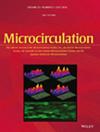Local control of blood flow depends on signaling to arterioles via upstream conducted responses. Here, the objective is to examine how electrical properties of gap junctions between endothelial cells (EC) affect the spread of conducted responses in microvascular networks of the brain cortex, using a theoretical model based on EC electrophysiology.
Modeled EC currents are an inward-rectifying potassium current, a non-voltage-dependent potassium current, a leak current, and a gap junction current between adjacent ECs. Effects of varying gap junction conductance are considered, including asymmetric conductance, with higher conductance for forward currents (positive currents from upstream to downstream, based on blood flow direction). The response is initiated by a local increase in extracellular potassium concentration. The model is applied to a 45-segment synthetic network and a 4881-segment network from mouse brain cortex.
The conducted response propagates preferentially to upstream arterioles when the conductance for forward currents is at least 20 times that for backward currents. The response depends strongly on the site of stimulation. With symmetric gap junction conductance, the network acts as a syncytium and the conducted response is dissipated.
Upstream propagation of conducted responses may depend on the asymmetric conductance of EC gap junctions.


